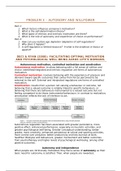Summary
Summary Course 3.3 Motivation, Selfregulation and Performance Problem 3
- Course
- Institution
Course 3.3 Motivation, Selfregulation and Performance Summary of all articles of Problem 3 - Autonomy and Willpower. Erasmus University Rotterdam. Psychology 3rd year.
[Show more]



